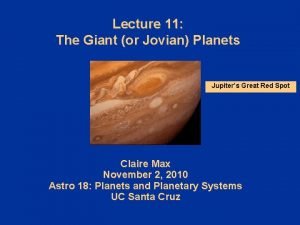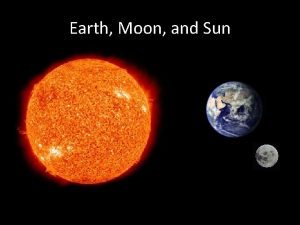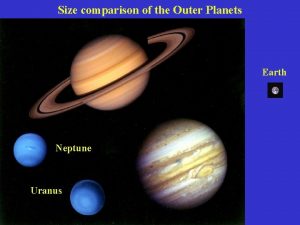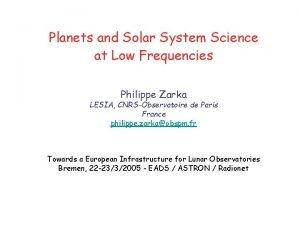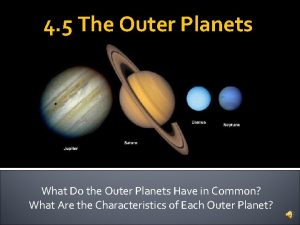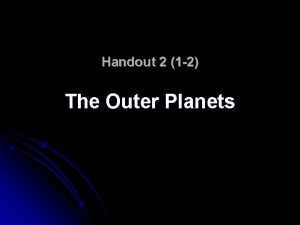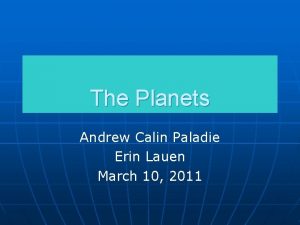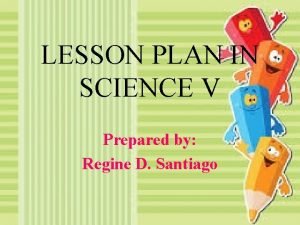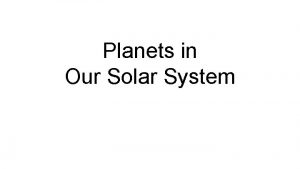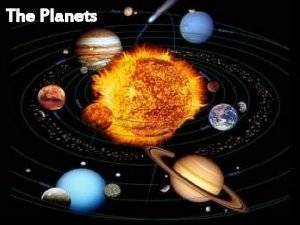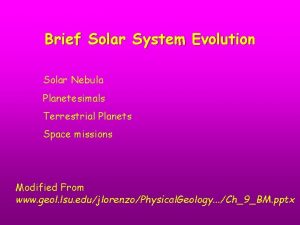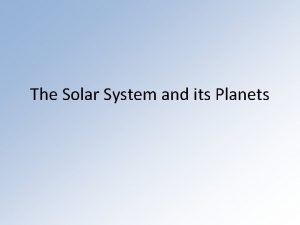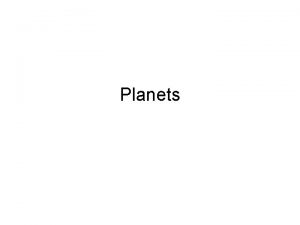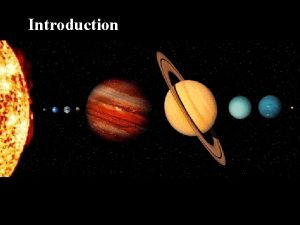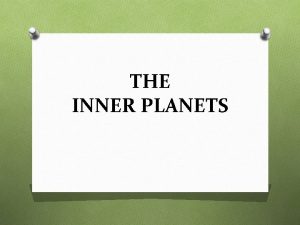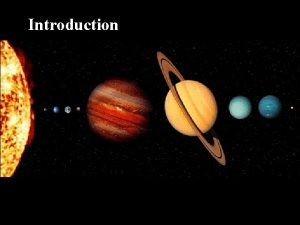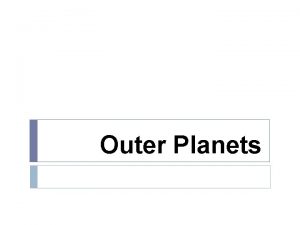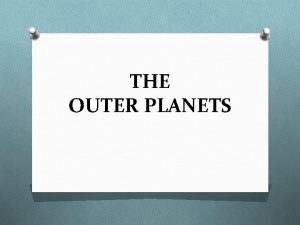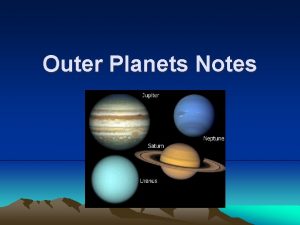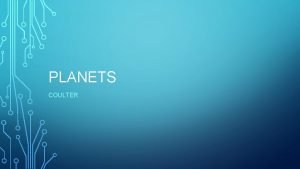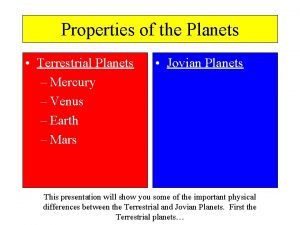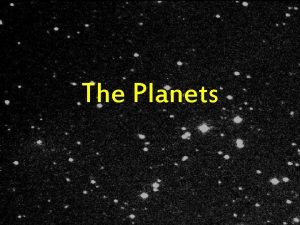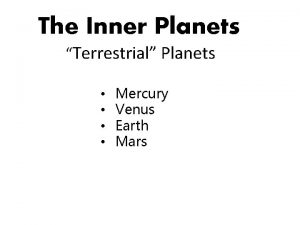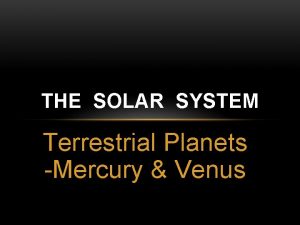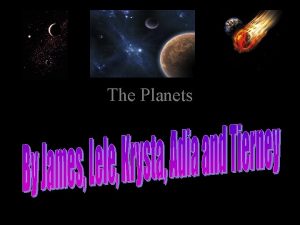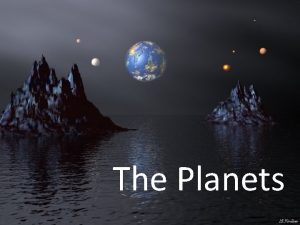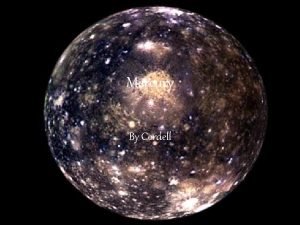Planets Mercury Mercury n n n n A





















- Slides: 21

Planets

Mercury

Mercury n n n n A terrestrial planet Closest planet to the sun No atmosphere Revolution period is 88 Earth days Rotation period is 58 days. This means that Mercury has 1 ½ Mercurian days per year. 3. 2 light minutes from the sun On Mercury, you weigh only 38 % of what you’d weigh on Earth.

Venus

Venus n n n n n Similar to Earth in size, mass and density Earth’s twin Retrograde Rotation-clockwise rotation 90 times the pressure of Earth’s atmosphere CO 2 and acids in atmosphere cause greenhouse effect 464 degrees C average surface temp, hottest planet Active surface i. e. volcanoes etc. 6 light minutes from the Sun 91% of Earth’s gravity

Earth

Earth n n n Liquid water was the key to the development of life on Earth Most likely the only planet that supports life Thick atmosphere that protects us from UV rays Period of revolution is 365 days, 6 hours Period of rotation is 23 hours, 56 minutes Distance from the sun is 8. 3 light minutes

Mars

Mars n n n n Cold planet and thin atmosphere Only water on Mars is in the form of ice Distance from sun is 12. 7 light minutes Water existed there in the past Has 2 polar ice caps 2 large volcanoes on it Period of revolution is 1 year and 322 days Period of rotation is 24 hours and 37 minutes.

Mars surface

Olympus Mons

Jupiter

Jupiter n n n Made primarily of hydrogen and helium. Has a storm called the “Great Red Spot” Radiates more energy into space than it receives. Largest planet in our solar system Period of rotation is about 10 hours. It is a butt 43. 3 light minutes from the sun.

Saturn

Saturn n n Saturn is the only planet that is still forming. It is the Second largest planet in our solar system. Gives off more energy than it receives. 1. 3 light hours from the sun. Known for its rings made of dust and ice particles.

Uranus

Uranus n n Uranus is blue-green in color. Has a large amount of water in its interior. It is tilted on its side. Thought to be caused by an impact. Has retrograde rotation ( sun sets in the south. )

Neptune

Neptune n n n Called the “Blue” planet. 4. 2 light hours from the sun. Has a storm called the “The Great Dark Spot. ” Takes 164 years to orbit the sun. At times is the farthest planet from the sun.

Pluto

Pluto n n The smallest planet in our solar system. The farthest planet from the sun. Has a moon “Charon” more than half of its size. Unlike the other Gas Giants it is made of rock and covered with a thin icy surface.
 Why are jovian planets bigger than terrestrial
Why are jovian planets bigger than terrestrial What separates the inner and outer planets
What separates the inner and outer planets What separates the inner planets and outer planets
What separates the inner planets and outer planets Inner terrestrial planets
Inner terrestrial planets What do the first four outer planets have in common?
What do the first four outer planets have in common? Characteristics of outer planets
Characteristics of outer planets Why do jovian planets have rings
Why do jovian planets have rings Diagram of earth moon and sun
Diagram of earth moon and sun Outer planets
Outer planets Solar system planets
Solar system planets What do all the outer planets have in common
What do all the outer planets have in common Matching planet rings
Matching planet rings Http://solarsystem.nasa.gov/planets/
Http://solarsystem.nasa.gov/planets/ Inner outer planets venn diagram
Inner outer planets venn diagram Inner planets
Inner planets Characteristics of outer planets
Characteristics of outer planets Gas planets
Gas planets Rotation of planets
Rotation of planets Elizabethan world view macrocosm microcosm
Elizabethan world view macrocosm microcosm Jupiter and saturn are noticeably oblate because:
Jupiter and saturn are noticeably oblate because: Http://solarsystem.nasa.gov/planets
Http://solarsystem.nasa.gov/planets Goldilocks planets
Goldilocks planets






